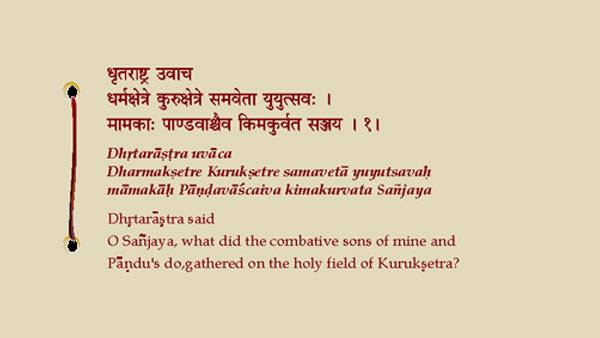The Bhagavad Gita, a sacred Hindu scripture, is a timeless source of wisdom and guidance. It is embedded with profound verses, known as shlokas, that offer insights into the nature of existence, the path to liberation, and the art of living a meaningful life.
How many shlokas in Bhagavad Gita: The Bhagavad Gita consists of 700 shlokas divided into 18 chapters.
The first shloka of the Bhagavad Gita starts with a question from Dhritarashtra to Sanjaya.

Here’s the translation of the first shloka:
“Dhratarastra said: O Sanjaya, gathered on the holy field of Kurukshetra, and desiring to fight, what did my sons and the sons of Pandu do?”
Key points to note:
- Dhritarashtra: The blind king of Hastinapur and father of the Kauravas.
- Sanjaya: A divine sage and charioteer of Dhritarashtra, blessed with divine vision to witness and describe the Kurukshetra War.
- Kurukshetra: The sacred battlefield where the epic Mahabharata war took place.
- The question: Dhritarashtra, unable to see the battlefield, asks Sanjaya to describe the scene and the actions of his sons (Kauravas) and his nephews (Pandavas).
This initial question sets the stage for the epic conversation between Lord Krishna and Arjuna, which forms the core of the Bhagavad Gita.
Following shloka of the Gita sets the stage for the profound conversation between Lord Krishna and Arjuna. It encapsulates the essence of the entire scripture, highlighting the dilemma of Arjuna and the divine intervention that follows.
Translation:
“Arjuna said: O Krishna, seeing my kinsmen arrayed before me for battle, my limbs fail, my mouth dries up, my hair stands on end, my body trembles, my mind is bewildered, and I seem to lose my sense of balance. I see ominous signs, O Govinda.”
Significance:
This shloka portrays Arjuna’s internal turmoil as he faces the moral dilemma of fighting against his own kin. He questions the righteousness of the war and expresses his fear and confusion. It is this moment of vulnerability that prompts Lord Krishna to impart his divine wisdom, leading to one of the most profound philosophical discourses in human history.
The Power of Shlokas in Gita
The shlokas of the Gita are more than just verses; they are living philosophies that have the power to transform lives. They offer practical guidance on various aspects of life, such as:
- The nature of reality: The Gita delves into the metaphysical nature of existence, explaining the concepts of the soul, the material world, and the ultimate truth.
- The path to liberation: It outlines the path to liberation from the cycle of birth and death, emphasizing the importance of self-knowledge, detachment, and devotion.
- The art of living: The Gita provides practical advice on how to live a balanced and fulfilling life, emphasizing the importance of performing one’s duties without attachment to the results.
Importance of Shlokas
The shlokas of the Gita continue to inspire and enlighten millions of people around the world. They offer timeless wisdom that is relevant to people of all faiths and backgrounds. By studying and reflecting on these verses, we can gain a deeper understanding of ourselves and the world around us.
How many Shlokas in Mahabharata?
The Mahabharata is one of the longest epic poems in the world, and its exact length can vary depending on the version. However, it is generally estimated to contain over 100,000 shlokas.
What is Soundarya Lahiri
Soundarya Lahari is a sacred Hindu text composed by the great sage Adi Shankara. It is a collection of 100 verses that praise the divine feminine energy, Shakti, in her form as Tripura Sundari.
The text is considered a masterpiece of Sanskrit literature, and it is revered by Hindus for its profound spiritual insights and poetic beauty. The verses explore the nature of the divine, the power of devotion, and the path to liberation.
Many people believe that chanting the Soundarya Lahari can bring immense spiritual benefits, including peace, prosperity, and enlightenment.